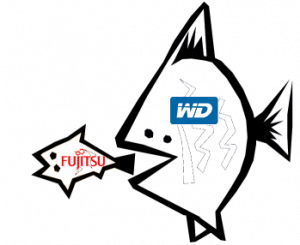 Reports are filtering in today that Western Digital has reached an agreement to purchase Fujitsu’s hard disk drive development and manufacturing assets. Already the world’s second-biggest drive manufacturer, Western Digital would edge closer to market-leader, Seagate, with the acquisition. The move would give WD even greater manufacturing capacity in Japan, the Philippines, and Thailand, and would potentially open up greater access to the laptop OEM market, where Fujitsu has performed well over the last few years.
Reports are filtering in today that Western Digital has reached an agreement to purchase Fujitsu’s hard disk drive development and manufacturing assets. Already the world’s second-biggest drive manufacturer, Western Digital would edge closer to market-leader, Seagate, with the acquisition. The move would give WD even greater manufacturing capacity in Japan, the Philippines, and Thailand, and would potentially open up greater access to the laptop OEM market, where Fujitsu has performed well over the last few years.
Let’s take a look at the two company’s product lines and market positions as we determine the impact of this deal.
Update: Fujitsu is denying the deal, even though the market loves it, but it still makes sense for WDC to pick up either Fujitsu or Hitachi’s disk drive business to better compete with Seagate.
Update 2: Rumors in December are that the deal is back on.
Final (?) Update: The deal is off as of January 2009.
Introducing Fujitsu
Although they’ve never enjoyed the high profile of (post-Maxtor) Seagate, Western Digital, and (post-IBM) Hitachi, sixth-ranked disk manufacturer, Fujitsu, has enjoyed success in two key OEM markets: Laptops and servers. The company’s disks are found in many portable computers (including my Apple MacBook Pro), sharing this market with number-three maker, Hitachi. Although Fujitsu reportedly does not manufacture their own drive wafers, they apparently handle all other aspects of design, construction, and assembly.
The company offers a variety of portable 2.5″ drives:
- The BH series is a thin 9.5 mm unit in capacities up to 320 GB
- The BJ is a high-performance 7200 rpm, 9.5 mm mechanism for high-end machines
- The new BT is fatter, at 12.5 mm, but reaches 500 GB
- Finally, the CJ is an upgrade to the BJ, with built-in encryption in addition to 7200 rpm and 9.5 mm thinness
In the enterprise space, Fujitsu offers both 2.5″ and 3.5″ models:
- The 3.5″ MBA3 is available in both Fibre Channel and SCSI variants at 10k and 15k rpm speeds and sizes to 300 GB
- The MBB2 is a 2.5″ drive for blade servers, with low power consumption, 10k rpm speed, and a SCSI interface
- The MBC2 bumps the 2.5″ drive up to 15k rpm
The company also offers a variety of 2.5″ drives for embedded use, with enhanced vibration and shock tolerance and 24×7 operation.
So let’s sum it up: Fujitsu is the number-six maker (in terms of sales), is strong in the OEM laptop and server markets, and has a respectably diverse set of drive offerings, but mostly focuses on 2.5″ mechanisms.
Western Digital
Now let’s turn to the reported buyer, Western Digital (NYSE: WDC). WDC is well known in the hot (and hotly competitive) retail space, selling buckets of external and portable USB hard disk drives to consumers. The company has been a fixture of the PC market for decades, originally as a manufacturer of a variety of components but focusing on hard disk drives in the early 1990s. The company has grown organically, only acquiring IP and R&D through acquisition rather than buying up its competitors like rivals Maxtor and Seagate. Reports say that Western Digital also buys their platters, but handles the rest of the engineering and construction activities in-house.
Western Digital’s Caviar line was the performance toast of the PC community in the 1990s, and they have recently had a resurgence with their Raptor and VelociRaptor drive units. The latter, a 10k rpm 2.5″ mechanism designed for desktops, was especially lauded in the press and blogs. Although their RE2 and RE3 enterprise SATA drive lines sport respectable specifications, Western Digital has never been a common sight in the data center.
On the mobile side, WDC has two lines: The 7200 rpm Scorpio Black and 5400 rpm Scorpio Blue. The latter is especially common wrapped in the company’s well-regarded My Passport portable USB enclosure, and is also used by OEMs like Verbatim. I transplanted one of these 320 GB Scorpio Blue drives into my MacBook Pro, in fact.
WDC’s bread and butter has long been its desktop drives, however. The company currently manufactures three lines of Caviar drives (Black, Blue, and Green) for different market segments, and their My Book external desktop drives are hot sellers in the consumer sector. The company boasts “green” drives with lower power requirements, as well as embedded units for DVRs like TiVo.
A Nice Match
So what would Fujitsu bring to Western Digital? Greater OEM leverage and increased manufacturing capability, chiefly, along with more R&D depth. Both companies have similar manufacturing capabilities, and Fujitsu’s strong OEM laptop and server lines would mesh nicely with WD’s existing desktop and consumer strength. Although the combined company would still trail Seagate in market share (30% vs. 35%), it would be a force to reckon with in the market, and could force further consolidation among the smaller players. Hitachi’s OEM drive manufacturing business would certainly face pressure, and they would have been a nice alternate target for Western Digital. All in all, I give this rumor two thumbs up!
nice